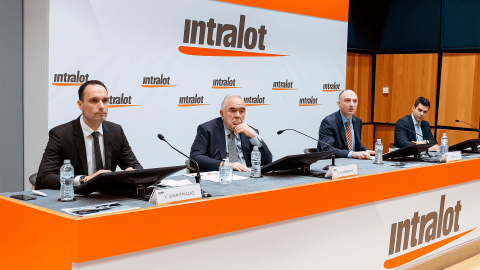Greek iGaming and Lottery Major Intralot S.A. Values Bally’s International Interactive at €2.7 Billion
Intralot S.A. has entered a binding pact to acquire Bally’s International Interactive for €2.7 billion (US$3.18 billion) in a cash-and-stock fusion that reshapes the global gaming landscape. The Greek lottery-technology pioneer will pay €1.53 billion in cash—underwritten by a Citizens-led banking syndicate—and issue an equal value of new shares, making Bally’s the deal’s largest shareholder. A planned €400 million equity raise in Athens will bolster financing, while Bally’s chief executive Robeson Reeves is slated to helm the enlarged group. Management projects €1.1 billion in annual revenue, a 38 percent EBITDA margin and free-cash-flow conversion above 90 percent, driven largely by the United Kingdom and North America.
Transaction Blueprint: Cash, Equity and Debt Commitments
Intralot will transfer €1.53 billion in cash to Bally’s and match that sum with newly issued shares—immediately positioning Bally’s as the dominant shareholder in the merged entity. The cash leg is secured by a consortium of lenders—Citizens Bank, Deutsche Bank, Goldman Sachs and Jefferies—providing bridge financing and term debt. To reinforce the balance sheet, Intralot plans a public share offering of up to €400 million on the Athens Stock Exchange, a move that should keep leverage within a disciplined band while preserving liquidity for integration costs and growth.
Governance Realignment and Leadership Transition
Upon closing—targeted for the fourth quarter of 2025—Bally’s chief executive Robeson Reeves will assume operational control of Intralot, injecting direct-to-consumer expertise into a firm historically steeped in B2B lottery contracts. Founder Sokratis Kokkalis will retain a significant stake and chair the board, offering regulatory continuity in markets where long-standing government relationships remain critical. Maintaining the Athens listing not only preserves Intralot’s Greek identity but is also expected to vault the combined entity into the exchange’s upper tier by market capitalization.
Strategic Logic: Marrying Lottery Infrastructure to Digital Scale
The acquisition welds Intralot’s global lottery technology—ticket terminals, central-system software and compliance frameworks—to Bally’s cloud-native iGaming suite and the Vitruvian analytics engine. The result is a diversified technology stack capable of serving state lotteries, casino operators and end-users alike. Management argues that this blend of hardware reliability and digital agility will accelerate product launches, shorten sales cycles and improve retention as jurisdictions liberalize online gambling.
Market Footprint: UK Dominance and North American Momentum
Analysts estimate the merged company will generate approximately €1.1 billion in annual revenue, with 60 percent emanating from the United Kingdom—where Bally’s Interactive commands strong brand equity—and more than 20 percent from the United States and Canada, where Intralot already supplies state lotteries. The enlarged pipeline also unlocks cross-selling: Bally’s will push digital wallets to Intralot’s retail lottery users, while Intralot introduces its instant-win mechanics to Bally’s sportsbook base.
Financial Metrics: Margin Ambition and Cash-Flow Discipline
Management is guiding toward a consolidated 38 percent EBITDA margin, supported by scale efficiencies, platform unification and procurement savings. Free cash flow conversion is forecast above 90 percent, reflecting the capital-light nature of cloud gaming compared with legacy slot-machine footprints. The €400 million equity raise should cap net debt near a 3.0× EBITDA multiple—comfortably inside covenants—while still leaving dry powder for selective bolt-on acquisitions in Asia-Pacific.
Competitive Context: Consolidation as a Survival Imperative
The tie-up fits a broader pattern of mergers within the gaming and lottery arena, where operators chase scale to absorb compliance costs, secure content pipelines and negotiate better data-hosting rates. Recent moves by Flutter Entertainment and Entain underscore the arms race for proprietary technology stacks. By folding Bally’s interactive engine into Intralot’s lottery backbone, the combined firm positions itself as a full-spectrum supplier, able to bid for omnichannel concessions that now dominate tender documents in Europe and the Americas.
Regulatory Milestones and Closing Conditions
Finalization remains contingent on antitrust clearance in Brussels, a “no-objection” ruling from the U.K. Gambling Commission and shareholder approval on both sides of the Atlantic. Early dialogue with regulators suggests the blend of lottery and iGaming assets raises limited concentration concerns, though authorities will scrutinize data-privacy safeguards and responsible-gaming protocols—areas where both firms claim mature frameworks.
Investor Takeaways: Risk, Reward and Catalysts
• Equity Upside: A rerating could follow successful integration, given the prospect of a top-tier Athens listing and dual revenue streams. • Execution Risk: IT migration and cultural integration will test leadership, especially as operations span everything from state-run draw games to mobile casino apps. • Cash-Return Policy: Management has not ruled out dividends once leverage normalizes, offering potential income alongside growth. • Regulatory Watch: Any tightening of U.K. bonus-cap rules or U.S. iGaming tax increases would pressure forecasts, underscoring the need for geographic diversification.
A €2.7 Billion Bet on the Future of Regulated Gaming
Intralot’s purchase of Bally’s International Interactive is more than a headline deal; it is a strategic play for relevance in an industry where technology convergence and regulatory complexity reward size and innovation. By fusing lottery hardware dependability with dynamic digital gaming, the new group aims to capture growth in both mature and emerging markets while delivering robust margins and cash flow. Investors will watch closely as management navigates execution hurdles, but the roadmap—anchored by strong funding, seasoned leadership and complementary assets—suggests a compelling blueprint for a next-generation gaming powerhouse.
